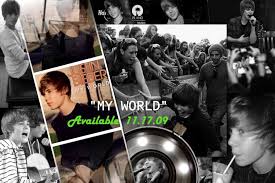Source (Google.com.pk)
Justin Bieber Screensavers Biography
Before the advent of LCD screens, most computer screens were based on cathode ray tubes (CRTs). When the same image is displayed on a CRT screen for long periods of time, the properties of the exposed areas of phosphor coating on the inside of the screen gradually and permanently change, eventually leading to a darkened shadow or "ghost" image on the screen. Cathode ray televisions, oscilloscopes and other devices that use CRTs are all susceptible to phosphor burn-in, as are plasma displays to some extent.
Screen-saver programs were designed to help avoid these effects by automatically changing the images on the screen during periods of user inactivity.
For CRTs used in public, such as ATMs and railway ticketing machines, the risk of burn-in is especially high because a stand-by display is shown whenever the machine is not in use. Older machines designed without burn-in problems taken into consideration often display evidence of screen damage, with images or text such as "Please insert your card" (in the case of ATMs) visible even when the display changes while the machine is in use. Blanking the screen is out of the question as the machine would appear to be out of service. In these applications, burn-in can be prevented by shifting the position of the display contents every few seconds, or by having a number of different images that are changed regularly.
Modern CRTs are much less susceptible to burn-in than older models due to improvements in phosphor coatings, and because modern computer images are generally lower contrast than the stark green- or white-on-black text and graphics of earlier machines. LCD computer monitors, including the display panels used in laptop computers, are not susceptible to burn-in because the image is not directly produced by phosphors (although they can suffer from a less extreme and usually non-permanent form of image persistence). For these reasons, screensavers today are primarily for decorative/entertainment purposes, or for password protection. They usually feature moving images or patterns and sometimes sound effects.

Justin Bieber Screensavers Biography
Bieber
announced via Twitter that the first single off Believe would be
released in March 2012. The following week, Bieber appeared on The Ellen
DeGeneres Show to announce that the first single would be called
"Boyfriend" and would be released on March 26, 2012. The song was
co-written by Mike Posner. The song debuted at number two on the U.S.
Billboard Hot 100 chart, selling a total of 521,000 digital units, the
second-highest-ever debut digital sales week. Bill Werde of Billboard
noted that it failed to debut at number one because the digital download
of the track was available only through iTunes Store, "restricting the
buying option for those that do not frequent the Apple retail
store."Boyfriend" became Bieber's first single ever to reach the top
position on the Canadian Hot 100 by debuting at number one and staying
on for one week
A
virtually untapped well of natural artistic talent, Justin Bieber is
primed to be a solid force in music for many years to come. "I think
older people can appreciate my music because I really show my heart when
I sing, and it's not corny," he says. "I think I can grow as an artist
and my fans will grow with me." And just think, he's just getting
started.
A screensaver is a type of computer program initially designed to prevent phosphor burn-in on CRT and plasma computer monitors by blanking the screen or filling it with moving images or patterns when the computer is not in use. Contemporary screensavers are used primarily for entertainment, security or to display system status information.
Decades before the first computers utilizing this technology were invented, Robert A. Heinlein gave an example of how they might be used in his novel Stranger In A Strange Land (1961).
Many modern television systems, media players and other entertainment systems have a form of screensaver integrated. Most simply display a logo moving around the screen.
A screensaver is a type of computer program initially designed to prevent phosphor burn-in on CRT and plasma computer monitors by blanking the screen or filling it with moving images or patterns when the computer is not in use. Contemporary screensavers are used primarily for entertainment, security or to display system status information.
Decades before the first computers utilizing this technology were invented, Robert A. Heinlein gave an example of how they might be used in his novel Stranger In A Strange Land (1961).
Many modern television systems, media players and other entertainment systems have a form of screensaver integrated. Most simply display a logo moving around the screen.
Before the advent of LCD screens, most computer screens were based on cathode ray tubes (CRTs). When the same image is displayed on a CRT screen for long periods of time, the properties of the exposed areas of phosphor coating on the inside of the screen gradually and permanently change, eventually leading to a darkened shadow or "ghost" image on the screen. Cathode ray televisions, oscilloscopes and other devices that use CRTs are all susceptible to phosphor burn-in, as are plasma displays to some extent.
Screen-saver programs were designed to help avoid these effects by automatically changing the images on the screen during periods of user inactivity.
For CRTs used in public, such as ATMs and railway ticketing machines, the risk of burn-in is especially high because a stand-by display is shown whenever the machine is not in use. Older machines designed without burn-in problems taken into consideration often display evidence of screen damage, with images or text such as "Please insert your card" (in the case of ATMs) visible even when the display changes while the machine is in use. Blanking the screen is out of the question as the machine would appear to be out of service. In these applications, burn-in can be prevented by shifting the position of the display contents every few seconds, or by having a number of different images that are changed regularly.
Modern CRTs are much less susceptible to burn-in than older models due to improvements in phosphor coatings, and because modern computer images are generally lower contrast than the stark green- or white-on-black text and graphics of earlier machines. LCD computer monitors, including the display panels used in laptop computers, are not susceptible to burn-in because the image is not directly produced by phosphors (although they can suffer from a less extreme and usually non-permanent form of image persistence). For these reasons, screensavers today are primarily for decorative/entertainment purposes, or for password protection. They usually feature moving images or patterns and sometimes sound effects.
Justin Bieber Screensavers
Justin Bieber Screensavers
 Justin Bieber Screensavers
Justin Bieber Screensavers
 Justin Bieber Screensavers
Justin Bieber Screensavers
 Justin Bieber Screensavers
Justin Bieber Screensavers
 Justin Bieber Screensavers
Justin Bieber Screensavers
 Justin Bieber Screensavers
Justin Bieber Screensavers
 Justin Bieber Screensavers
Justin Bieber Screensavers
 Justin Bieber Screensavers
Justin Bieber Screensavers
 Justin Bieber Screensavers
Justin Bieber Screensavers
 Justin Bieber Screensavers
Justin Bieber Screensavers
 Justin Bieber Screensavers
Justin Bieber Screensavers
 Justin Bieber Screensavers
Justin Bieber Screensavers
No comments:
Post a Comment